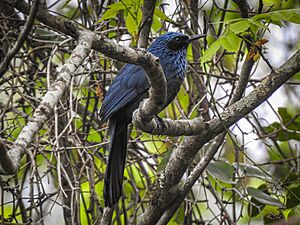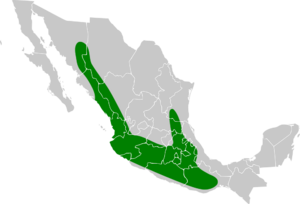Blue mockingbird facts for kids
Quick facts for kids Blue mockingbird |
|
|---|---|
 |
|
| Conservation status | |
| Scientific classification | |
| Genus: |
Melanotis
|
| Species: |
caerulescens
|
 |
|
The blue mockingbird (Melanotis caerulescens) is a cool bird that lives only in Mexico. Sometimes, it might fly north into the southern United States for a visit! It likes to live in dry forests, moist mountain forests, or even places where forests used to be.
This bird is super blue all over its back, tail, wings, head, and tummy. Its blue color comes from how its feathers are built, not from a color pigment. This means it can sometimes look gray if it's in the shade.
The blue mockingbird has a black "mask" around its reddish-brown eyes. It also has a fairly long tail that gets a bit narrower at the end. You might see dark blue streaks on its chest. Its beak is long, thin, and slightly curved. Its legs and feet are black.
Blue mockingbirds are about 9.5–10.5 in (24–27 cm) long. They weigh between 50.2 and 59.7 g (1.77 and 2.11 oz). That's about the weight of a few strawberries!
Contents
Bird Families and Names
Scientists group animals into families. The blue mockingbird belongs to the Mimidae family. This family includes mockingbirds and thrushes.
When William Swainson first described this bird in 1827, he thought it was a type of mockingbird. Later, in 1850, another scientist named Charles Lucien Bonaparte moved it to its own special group, Melanotis. Most scientists agreed with him.
There are two main types, or subspecies, of the blue mockingbird:
- M. c. caerulescens: This type lives in the pine and oak forests of western Mexico. You can find it from southern Sonora down to the Isthmus of Tehuantepec.
- M. c. longirostris: This type lives only on the Tres Marías Islands. These islands are off the coast of western Mexico.
The name caerǔlěus comes from a Latin word. It simply means "blue."
Where They Live
The blue mockingbird lives in many different kinds of woodlands. It likes humid forests, thick bushes near rivers, and pine-oak forests. It can be found from lowlands all the way up to mountains 2,450 m (8,040 ft) high.
What They Do
Building Nests
When it's time to have babies, the blue mockingbird builds a cup-shaped nest. It makes its nest from small twigs and roots.
What They Eat
The blue mockingbird eats both plants and animals. It mostly eats small bugs and other invertebrates. But it also enjoys some fruits and other plant parts.
Protecting Blue Mockingbirds
The blue mockingbird is not currently in danger. The International Union for Conservation of Nature says it is a species of least concern. This is because it lives in a very large area. Also, there are many of them, with an estimated population of 500,000 to 4,999,999 birds.
However, scientists have noticed that their numbers are slowly going down. This is mainly because their habitat (the places where they live) is being broken up or lost. The Mexican government is especially watching the longirostris subspecies. They have named it a species of "special concern."


